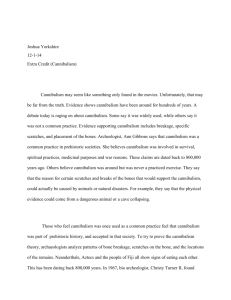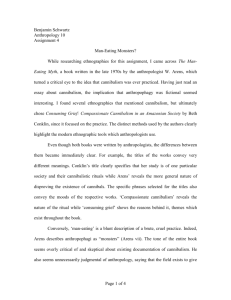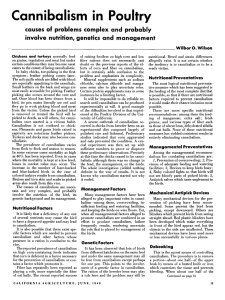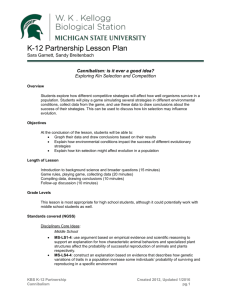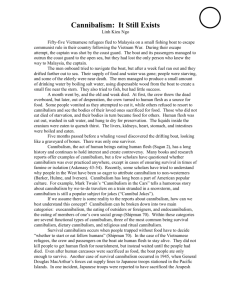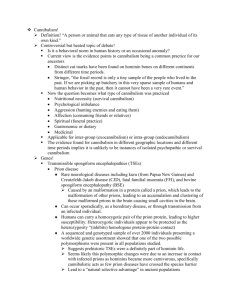Default Normal Template
advertisement
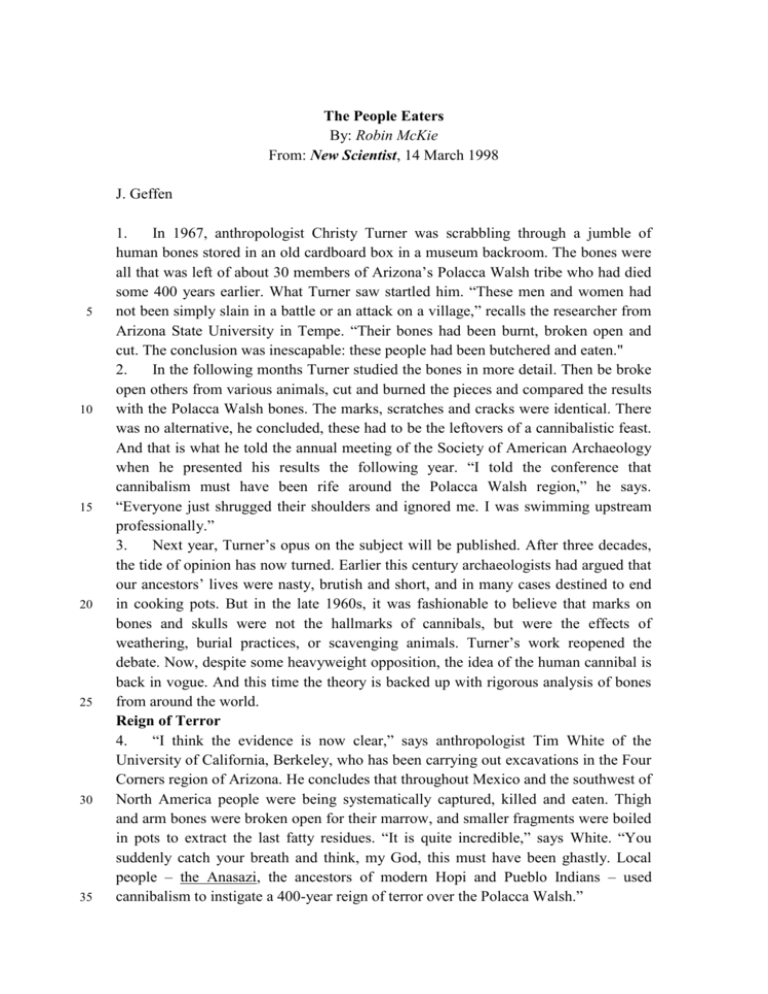
The People Eaters By: Robin McKie From: New Scientist, 14 March 1998 J. Geffen 5 10 15 20 25 30 35 1. In 1967, anthropologist Christy Turner was scrabbling through a jumble of human bones stored in an old cardboard box in a museum backroom. The bones were all that was left of about 30 members of Arizona’s Polacca Walsh tribe who had died some 400 years earlier. What Turner saw startled him. “These men and women had not been simply slain in a battle or an attack on a village,” recalls the researcher from Arizona State University in Tempe. “Their bones had been burnt, broken open and cut. The conclusion was inescapable: these people had been butchered and eaten." 2. In the following months Turner studied the bones in more detail. Then be broke open others from various animals, cut and burned the pieces and compared the results with the Polacca Walsh bones. The marks, scratches and cracks were identical. There was no alternative, he concluded, these had to be the leftovers of a cannibalistic feast. And that is what he told the annual meeting of the Society of American Archaeology when he presented his results the following year. “I told the conference that cannibalism must have been rife around the Polacca Walsh region,” he says. “Everyone just shrugged their shoulders and ignored me. I was swimming upstream professionally.” 3. Next year, Turner’s opus on the subject will be published. After three decades, the tide of opinion has now turned. Earlier this century archaeologists had argued that our ancestors’ lives were nasty, brutish and short, and in many cases destined to end in cooking pots. But in the late 1960s, it was fashionable to believe that marks on bones and skulls were not the hallmarks of cannibals, but were the effects of weathering, burial practices, or scavenging animals. Turner’s work reopened the debate. Now, despite some heavyweight opposition, the idea of the human cannibal is back in vogue. And this time the theory is backed up with rigorous analysis of bones from around the world. Reign of Terror 4. “I think the evidence is now clear,” says anthropologist Tim White of the University of California, Berkeley, who has been carrying out excavations in the Four Corners region of Arizona. He concludes that throughout Mexico and the southwest of North America people were being systematically captured, killed and eaten. Thigh and arm bones were broken open for their marrow, and smaller fragments were boiled in pots to extract the last fatty residues. “It is quite incredible,” says White. “You suddenly catch your breath and think, my God, this must have been ghastly. Local people – the Anasazi, the ancestors of modern Hopi and Pueblo Indians – used cannibalism to instigate a 400-year reign of terror over the Polacca Walsh.” The People Eaters / 2 40 45 50 55 60 65 70 75 5. In other words, according to White, nourishment was not the Anasazi’s main reason for eating their neighbours. The primary motivation was subjugation. The threat of being eaten must have filled the Polacca Walsh with a terror greater even than that of mere death, helping to cow them into submission. 6. The Polacca Walsh lived relatively recently. However, other research suggests cannibalism has a long and ignoble history among humans. For example, in the past few years, palaeontologists working at an 800,000 year-old settlement uncovered at Atapuerca in Spain have found clear signs that our early ancestors lunched on each other with relish. “The evidence is strong,” says Yolanda Fernandez-Jalvo of Madrid’s Natural History Museum. “Human bones at Atapuerca have cut marks and had clearly been stripped of their flesh. They were also mixed up with bones of animals that had been eaten.” 7. And the practice has not necessarily been consigned to the distant past. There have been a plethora of reports about recent cases of anthropophagy (human-eating). During the famines in Stalin’s Russia, there were tales of communities surviving on human flesh. And cannibalism continues in the former Soviet Union, it seems. Last year, a 73-year-old woman was arrested after police discovered the half-eaten body of her 82-year-old husband in their flat. Three months later, two Ukrainian prisoners were found guilty of eating their cellmate, while two Russian soldiers were alleged to have consumed a comrade. Each story was covered in gory detail by the US and British press. In Russia, they scarcely made news. 8. Going back to the 16th century, there are the stories about the Aztec empire. The conquistadors alleged that the Aztecs were in the habit of butchering and eating their prisoners, although in the past historians have tended to view such claims as attempts to justify Spanish aggression. White disagrees, pointing out that carefully splintered human bones have been found at several Aztec temple sites. “The evidence shows that the Aztecs really were cannibals,” he says. 9. Perhaps most revealing of all is a story related by the distinguished anthropologist Jared Diamond from the University of California, Los Angeles, in his most recent book, Guns, Germs and Steel. He tells of boatloads of Maori warriors landing on Rekohu (Chatham Islands), 500 miles east of New Zealand, in 1835 and announcing that the local Moriori people were now their slaves. Without waiting for a response, they set upon the islanders. “They killed hundreds of Morioris, cooked and ate many of the bodies, and enslaved all the others, killing most of them over the next few years,” writes Diamond. He quotes one Maori who justified this savagery by saying: “No one escaped. But what of that? It was in accordance with our custom.” 10. And there you have it: “in accordance with our custom”. Our natural tendency is to eat our opponents as a means of ritually finishing off the slaughter of battle, or of ensuring a good meal when times are hard, or both. The evidence seems overwhelming. The People Eaters / 3 80 85 90 95 100 105 110 115 11. Not everyone agrees, however. British archaeologist Paul Bahn admits that a belief in cannibalism seems to be inherent in humans, with tales stretching back to the Greek myths of Saturn devouring his children and the Cyclops eating Odysseus’s sailors. But most “authenticated” stories turn out to be “based on heresy, and lack any reliable first-hand witnesses”, he says. “Cannibalism always turns out to be practised by the next tribe or the next country,” says Bahn. The Romans thought the ancient Britons were cannibals. The British claimed the ancient Irish ate each other. Henry Kissinger even remembers Leonid Brezhnev telling him that the Chinese were cannibals. “You hardly ever find an actual authenticated case,” says Bahn. “Indeed, the very etymology of the word – coined by Columbus from the name of the Carib people of the Caribbean – shows it has roots based in ignorance and prejudice.” 12. I don’t say that cannibals don’t exist,” admits Bahn. Deranged people can do some dreadful things to their fellow humans. But cases are really very rare and only occur in special circumstances, usually when people are starving.” William Arens, professor of anthropology at the State University of New York at Stony Brook, agrees. He launched the original counterblast to the idea that human cannibalism was ubiquitous throughout history and prehistory. And in his book The Man-Eating Myth: Anthropology and Anthropophagy, published in 1979, he surveyed dozens of stories about cannibalism and concluded that only a few stood up to scrutiny. The archaeological evidence was usually circumstantial, while reliable eyewitnesses of human flesh feasts always seemed to be lacking. “It was bad science,” says Arens. Why Eat Humans? 13. His views slowly became orthodoxy, forcing researchers like White and Turner to approach their work with greater care and exactness. Arens admits that standards are now more rigorous, and also concedes that he has yet to study the Anasazi evidence in detail, but he remains unconvinced about the claims as a whole. “I still do not think cannibalism has been a major feature of human life,” he says, “and I don’t see why people strive so hard to try to prove that it is – except to try to show how wonderfully advanced we now are, compared to our crude past.” 14. Most anthropologists and palaeontologists, including Chris Stringer of London’s Natural History Museum, hold more moderate views. Stringer’s recent work includes excavations at Cheddar Gorge in Somerset, where he uncovered 12,000-year-old skeletons that had been scalped and beheaded. Their tongues had been cut out and their bones smashed open to extract the marrow. “There is no doubt that cannibalism was not an infrequent practice. The question is, what sort of cannibalism was it?” says Stringer. “Was it ritual cannibalism? Or was it done to obtain nutrition and, if so, was it simply to avoid starvation? Or was it a widespread business in which victims were captured and cooked? It is very difficult to say.” Frozen Food 15. Certainly, cases of cannibalism in desperate times have been recorded. Stranded sailors, isolated communities and explorers in extremis have all turned to deceased The People Eaters / 4 120 125 130 135 140 145 150 155 companions for a meal. The 1972 plane crash in the Andes, in which survivors ate the flesh of dead victims, is the most renowned case of recent times, though the story of Alfred Packer, the first American to be convicted of cannibalism, remains a classic. While prospecting for gold in Colorado’s San Juan Mountains in 1873, Packer became trapped in a shack during a blizzard and survived by eating his fellow prospectors. He was arrested, tried and sentenced to 40 years’ imprisonment, but served only 15. “You are a low-down depraved son of a bitch,” the judge told him. “There were only seven Democrats in Hinsdale county, and you ate five of them.” 16. Equally, reports of ritual cannibalism, in which parts of a dead relative are consumed as a mark of respect, are common. The most famous example is the New Guinean highlanders’ former practice of eating the brains of recently deceased tribesmen. It was this habit which is said to have led to the spread of laughing sickness – kuru – through tribes such as the Foré. The disease was endemic until the Australian government established control over the region in 1959. 17. Diamond believes that this may not be an example of ritual cannibalism in the strict sense. Children in the New Guinea highlands have the swollen bellies characteristic of a high-bulk but protein-deficient diet. New Guineans old and young routinely eat mice, spiders, frogs and other small animals that peoples elsewhere with access to large domestic mammals or large wild game species do not bother to eat. “Protein starvation is probably also the ultimate reason why cannibalism was widespread in traditional New Guinea highland societies,” he states in Guns, Germs and Steel. 18. Arens is even more circumspect about reports of cannibalism in New Guinea. The scientist who linked kuru to the eating of human flesh is Carleton Gadjusek. He received the Nobel prize for his discovery and illustrated his acceptance lecture with photographs of New Guineans eating human flesh. “In fact, Gadjusek has since admitted to me that the Foré tribesmen were eating pork,” says Arens. “Indeed, I don’t think he ever witnessed cannibalism in New Guinea.” 19. No one questions the research done in the US, for it is here that anthropologists, among them Turner and White, have honed techniques for analysing human remains. White chose to study a small Anasazi village called Mancos on the Colorado plateau. Archaeologists had already discovered 2106 bone fragments there – the remains of 17 adults and 12 children – and dated them to around 800 years ago. Using an electron microscope, White was able to distinguish between marks left by butchering and the indentations made by a gnawing animal. He even spotted a distinctive form of abrasion which he calls pot polish – shiny marks made when bones are stirred in a pot. He has concluded that these people had their heads cut off and were roasted. Later their bones were broken open and their marrow eaten. 20. Turner has also adopted a rigorous set of criteria for determining whether skeletal remains were cannibalised: signs of cutting with tools, indications that bones had been broken around the time of death to obtain marrow, burning, and missing The People Eaters / 5 160 165 170 175 vertebrae (crushed to get at the juicy marrowbone jelly). Using these criteria, Turner has revealed identical patterns of cuts and abrasions at 40 different archaeological sites. It seems that humans were feasting on humans throughout the region. 21. Bahn is unconvinced. “I don’t doubt the care they have taken, or the rigour of their analyses,” he says. He even accepts that many of the marks on bones were created by humans. “But they simply have not thought about the possibility that these cuts and scrapes could be the result of mortuary practice,” he says. “You have to consider this first. After all, isn’t it amazing that this outbreak of savage cannibalism erupted so suddenly from nowhere in this one part of the world?” 22. But perhaps the most intriguing criticism of our supposed anthropophagic urges comes in a coda added to a recent article by Arens in The Times Higher Education Supplement. Surveying the various preferred methods for cooking humans, Arens discovered that pots of water were favoured in Africa, clay ovens in the South Pacific, charcoal pits in America, while the New Guineans had a penchant for steam cooking. “Boiled, broiled, baked and steamed – but no recipes,” observes Arens. “The inability to provide this minor but crucial bit of evidence on the presumed custom of maneating is probably the best reason to conclude that cannibalism exists more in the limited culinary imagination of the observer than in the native appetite.” 23. For his part, White remains convinced that throughout history and prehistory humans have had the urge to eat each other. “To say they didn’t is the archaeological equivalent of saying Clinton lit up and didn’t inhale.” The People Eaters / 6 Answer in your own words. 1. Answer the question below in English. On what point did the archaeologists of the 1960s – paragraphs 1-3 – differ from those of the first half of the century? Answer : ____________________________________________________________ 2. Answer the question below in English. What thesis – paragraph 3 – seems to have recently gained acceptance? Answer : ____________________________________________________________ 3. Answer the question below in English. To what end did the Anasazi – paragraph 4 – resort to cannibalism? Answer : ____________________________________________________________ Answer the question below in Hebrew. 4. In what sense are the cases of cannibalism reported in paragraph 7 rather irrelevant to the issue at hand? Answer : ____________________________________________________________ 5. 6. Answer the question below in English. Compare and contrast the Aztec practices with the cases reported from the former Soviet Union. How do they differ? Answer : ____________________________________________________________ Answer the question below in English. What did the Maoris of the 19th century have in common with the Aztecs? Answer : ____________________________________________________________ The People Eaters / 7 7. 8. 9. 10. 11. Answer the question below in English. How does Paul Bahn – paragraphs 11-12 – treat the widespread accounts of cannibalism? Answer : ____________________________________________________________ Answer the question below in English. To what does Arens – paragraph 13 – attribute the repeated attempts of some researchers to prove that cannibalism had been a widespread phenomenon in human history? Answer : ____________________________________________________________ Answer the question below in English. What cases of cannibalism – paragraph 15 – are verifiable? Answer : ____________________________________________________________ Answer the question below in English. Why does the notion of ritual cannibalism in New Guinea – paragraph 17 – appear questionable to Jared Diamond? Answer : ____________________________________________________________ Answer the question below in English. Provide the information – paragraph 18 – suggesting that social scientists may achieve great renown on the basis of claims which may later prove unfounded. Answer : ____________________________________________________________ Answer the question below in Hebrew. 12. On what grounds did White and Turner – paragraphs 19-20 – assert that cannibalism was indeed practised by some native American tribes? Answer : ____________________________________________________________ The People Eaters / 8 Answer the question below in Hebrew. 13. What does Bahn – paragraph 21 – find rather amazing, and what may he be insinuating? The answer, though not stated, could be inferred. Answer : ____________________________________________________________ 14. Name the researchers who question the whole notion of cannibalism. Answer : ____________________________________________________________

